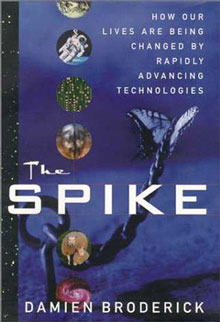Surfing The Singularity: Damien Broderick
May 18, 2001 by Amara D. Angelica
In The Spike (Forge, 2001), Damien Broderick takes us on a wild, hyperkinetic ride through some of the planet’s most imaginative ideas on the accelerating times ahead.
Originally published May 18, 2001 on KurzweilAI.net.
This is the first in the Surfing the Singularity series, which profiles big thinkers on the coming hyperexponential acceleration in technology and intelligent machines.
There’s brain-uploaded cyborg posthumans, transhumans, matter-compiled ultraintelligent machines, “minting” to put invisible nanotechnological machines to work building just about anything, the Far Edge party (planned for the edge of the universe in 200,000 years), “Genie”–a nanoengineered machine as smart as a person that works for free, mind uploading, Frank Tipler’s Omega point–how to survive the Big Crunch at the end of the universe (although astronomers, as Broderick notes, no longer expect a Big Crunch but rather a Big Whimper as everything accelerates apart forever).
And dystopia: Gray goo (out-of-control nano molecules), blue goo (“police nanos” to combat the gray goo), mind snatchers copying uploaded minds, “unbalanced superminds let loose in the playground of the solar system…Crazed gene engineers decide to build a bug tailored to wipe out, say, all obese redheads….”
The Spike (so called because the Singularity’s exponential technology growth curve resembles a spike, an “upward jab on the chart of change, a time of upheaval unprecedented in human history”) picks up where Vernor Vinge leaves off with his classic essay, “The Technological Singularity.” As Broderick puts it: “the place where the future starts to go completely opaque.”
A senior research Fellow at the University of Melbourne in Australia, Broderick holds a multi-disciplinary PhD from Deakin University in the comparative semiotics of science and literature. He is recognized as Australia’s dean of science fiction, with 28 books and countless essays, short stories, and articles reaching back to the early 1960s. He’s best known for his science fiction novels, including the award-winning The Dreaming Dragons, now revised and updated as The Dreaming.
His fiction catches the literary and kinetic excitement of 1950s and 1960s classic sf, which combined the glorious freedoms and scale of science with poetic pizzazz, in the works of Alfie Bester, Theodore Sturgeon, James Blish, Poul Anderson, Thomas M. Disch, Samuel R. Delany, and Joanna Russ. There’s also a gonzo edge, in the style of Ed Regis, Dennis Overbye, Rudy Rucker, and Mondo 2000.
It shows in The Spike, a compelling read–at times overwhelming, from what Timothy Leary called RPMs, revolutionary ideas per minute. It’s also an entertaining intro to influential transhumanists, extropians, singularitarians, and other Spike-conscious and often quirky folk.
But perhaps the most important parts of The Spike are the alternate possible paths to the Singularity and timelines, summarized in an essay reprinted on KurzweilAI.net, “Tearing Toward The Spike,” an abbreviated version of the final chapter of the book.
The book also paints vivid pictures of what it might be like as we approach the Singularity. (Excerpts will be added to KurzweilAI.net shortly.)
“I hope that if I can help stop religious and other nutters from slowing the curve down, I might still be here in time for some of the life-extending and enhancing technologies to kick in,” Broderick told me. “That needs to happen by, say, 2025, or my chook’ll be barbee’d (unless cryonics shows more promise than at present). If it’s not due until 2050 or 3000, I don’t have that much at stake on a personal level.
“What I tried to do was pull together and popularize a bunch of notions already floating around in memespace but apparently uncoordinated (and of course some of them are mutually inconsistent, leading to variant possible futures).”
But one idea is original: a “very fast evolution machine, where I speculate that the very earliest moments of the Big Bang might contain enough compressed phase transitions and speedy interactions to have allowed life and intelligence to evolve right at the outset, thereafter placing its impress on the architecture of the expanding, cooling cosmos.” In other words, the seeds of life might have started way back when the universe was formed, not several billion years ago.
“I put this idea to quantum theorist Seth Lloyd, who found it interesting and did some back of the envelope calculations suggesting it wasn’t entirely a dumb idea.”
Broderick says the Singularity theme can be glimpsed in his The Judas Mandala, where he coined the term “virtual reality.” The prescient science-fiction novel is partly set in a future 4000 years hence, where remnant humans of various kinds survive as protected pets of very fast running “cyborgs” (enhanced uploads). It was written in the mid ’70s and published in 1982.
And his 1978 story “A Passage in Earth” starts like this:
When I started growing Mahala I knew she’d be my benediction to an altered Earth, spinning sixteen solar years ahead and to one side of our cruddy battered prow. But the details were up for grabs. You can’t trust humans to sit still, even when they’re riding an e exponent rollercoaster. I knew they’d have changed in ten thousand years, Mahala’s distant genetic cousins, but I certainly didn’t guess then that they’d have done the demi-god thing: wound up strutting out their own archetypes. Maybe (in the limit, as we analytic types say) it was inevitable.
“That’s a sort of Spike, but one arrested into Finnegans Wake myth territory,” explains Broderick. “My forthcoming novel from Tor Books, Transcension (written with the help of Rory Barnes and Barbara Lamar), is a thoroughly post-Singularity novel, but told from the perspective of what amounts to Amish resisters to the Spike who live under the Joyous Relinquishment.”
“Damien Broderick’s The Spike takes us on a rapid vertical incline of the Singularity,” says extropian artist Natasha Vita-More. “The amplitude of this bolstering upward reach of technology cannot be slowed down or turned back. What we can do is to actively deal with it, and promptly. Humanity wants progress. We need to decide how much, how often, with whom and by what means. The central issue of our technological spike is not just a technological issue, but one for all society. In order to escalate willingly and knowledgeably along with the spike, we need to understand the sharp increase and potential of superintelligences as they evolve. Broderick skillfully provides this challenging opportunity.”
Links:
DAMIEN BRODERICK UNOFFICIAL HOMEPAGE


Footnotes

